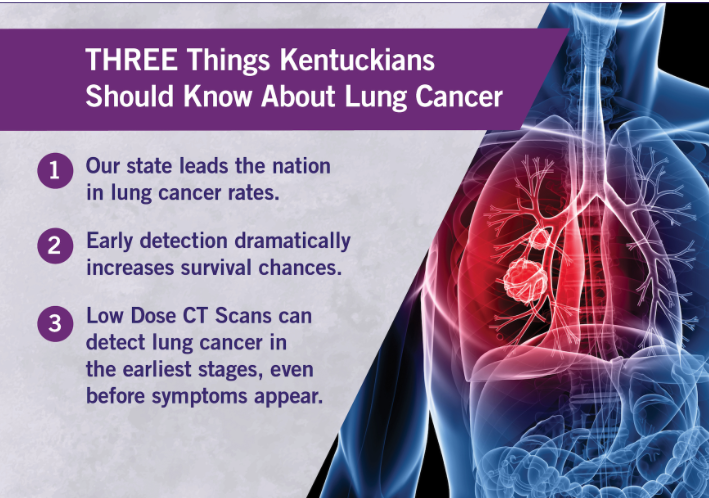Lung cancer continues to take a toll on thousands of Kentuckians each year. Both the smoking rate and lung cancer incidence rate in Kentucky are higher than the national average, according to the American Lung Association. Kentucky continues to have the highest rates of lung cancer in the country – the disease is expected to kill more than 3,500 Kentuckians this year alone, according to the American Cancer Society. As November approaches, a time to promote lung cancer awareness, KentuckyOne Health is encouraging community members to learn about screening options to help catch lung cancer early.
“Unfortunately, when lung cancer cases are diagnosed at a later stage, cancer has often spread to other organs and the survival rate is much lower,” said David Wallace, MD, KentuckyOne Health Primary Care Associates. “It’s important during Lung Cancer Awareness Month that community members take the time to learn about ways to reduce their risk for lung cancer, and precautions to catch the disease early.”
The American Lung Association reports that only 18.1 percent of lung cancer cases in Kentucky are caught in the early stages when the survival rate is much higher – approximately 48.8 percent. In addition, 52.5 percent of lung cancer cases in the commonwealth are not caught until later stages when the survival rate is only 3.2 percent.

Kentucky One Health
“Smoking is the leading cause of lung cancer, with 80 percent of cancer deaths caused by smoking,” said Dr. Wallace. “Lung cancer can also occur in those that don’t smoke. Additional risk factors for developing lung cancer include a family history of lung cancer and exposure to secondhand smoke, radon gas, asbestos and other carcinogens.”
Lung cancer forms in the tissues of the lung, usually in the cells lining the air passages. The recommended screening for lung cancer is a low-dose computed tomography (CT) scan. During this test, an X-ray machine scans the entire body, using low doses of radiation to make detailed pictures of the lung. This screening can help spot lung cancer in the early stages and is recommended annually for those who have a history of heavy smoking, have quit smoking within the past 15 years, and are between 55 and 80 years old. Data show that a low-dose CT screening is more likely to detect a mass, compared to a traditional chest X-ray.
In its earliest stages, lung cancer typically doesn’t show symptoms. Once the disease has advanced, those with lung cancer may notice the following symptoms:
· Coughing that gets worse and doesn’t go away
· Chest pain
· Shortness of breath
· Wheezing
· Coughing up blood
· Feeling very tired all the time
· Weight loss with no known cause
Once diagnosed with lung cancer, your physician will help you determine the best course of treatment, which may include surgery, video assisted thoracoscopic surgery (VATS), chemotherapy or radiation therapy.
Kentucky One Health
















